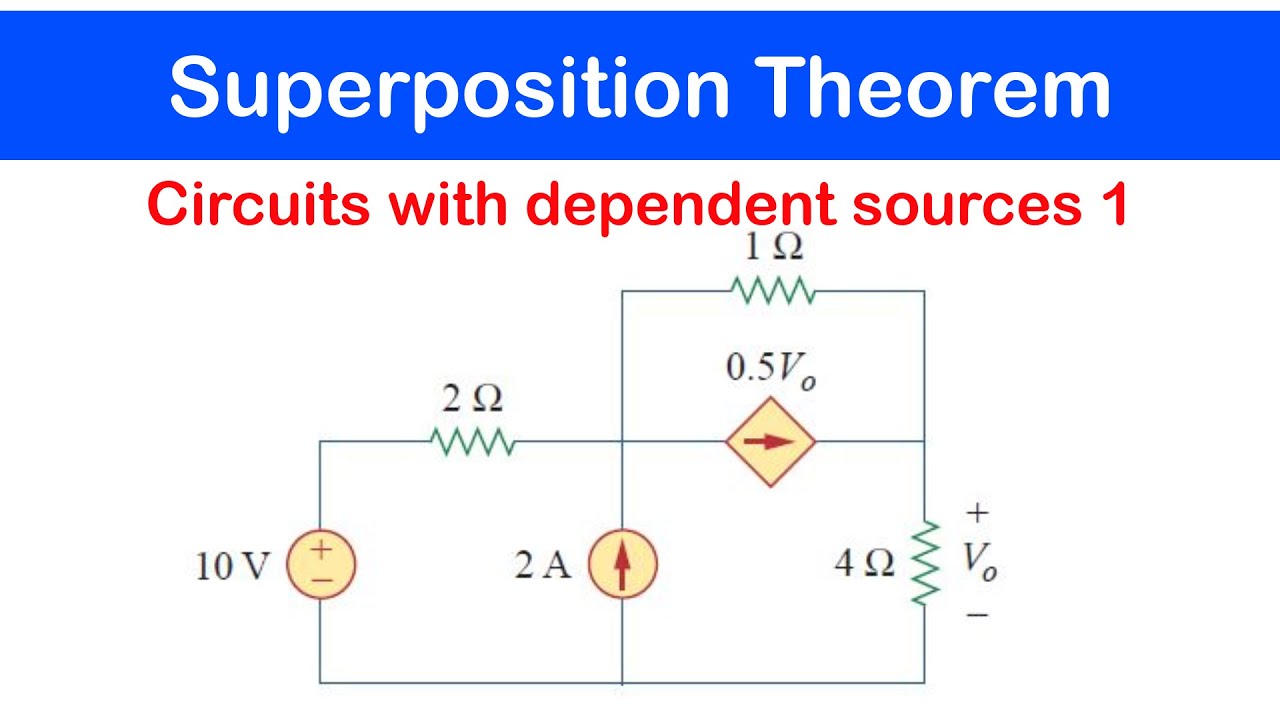Superposition Examples (Circuits for Beginners #14)
Summary
TLDRThis instructional script demonstrates using superposition to solve circuit problems with multiple sources. Through step-by-step examples, the narrator zeroes individual voltage and current sources, explains why a zeroed current source is an open circuit and a zeroed voltage source is a short, and applies Ohm’s Law to find contributions from each source. Starting with a two-source problem and progressing to three-source and more challenging two-source examples, the video shows resistor combinations, parallel and series simplifications, polarity considerations, and symmetry arguments to compute voltages and currents. The clear walkthrough builds problem-solving intuition for analyzing complex circuits using superposition.
Takeaways
- 😀 Superposition principle is a method used in circuit analysis where the effect of each independent source is considered separately and then combined.
- 😀 When analyzing a circuit, zero out each source one at a time: replace voltage sources with short circuits (wires) and current sources with open circuits (breaks).
- 😀 Ohm's Law (V = IR) is applied at each step to find the voltage, current, or resistance contributions from each source.
- 😀 For a voltage source, when it's 'zeroed out,' it behaves like a short circuit with no resistance, and no current flows through any resistor in the branch containing it.
- 😀 When a current source is 'zeroed out,' it behaves like an open circuit, meaning no current flows through any resistor in the branch containing it.
- 😀 In a circuit with two sources, each source's contribution to the voltage or current is calculated independently, then summed to find the total result.
- 😀 The combination of resistors (in series or parallel) plays a significant role in calculating the total resistance and current in the circuit.
- 😀 A parallel resistor combination reduces the overall resistance, while series resistors add up to form a higher total resistance.
- 😀 In more complex circuits with multiple sources, superposition allows you to simplify the problem by isolating each source's effect.
- 😀 For more difficult circuits, shorting and opening the right sources can significantly simplify the circuit and make the analysis more manageable.
- 😀 Understanding the polarity of voltage and direction of current is crucial when calculating the individual contributions from each source.
Q & A
What is the method used to solve the circuit problem in the video?
-The method used is superposition, where each source is considered independently and their individual contributions are then added together to find the overall result.
What does 'zeroing out' a current source mean in superposition?
-'Zeroing out' a current source means turning the current source to zero, which results in an open circuit where no current flows through it.
What happens when a voltage source is 'zeroed out' in the superposition method?
-Zeroing out a voltage source means setting the voltage to zero, effectively creating a short circuit across the voltage source in the circuit.
Why does the 15 ohm resistor become irrelevant when the 1 ampere current source is zeroed out?
-When the current source is zeroed out, no current flows through the 15 ohm resistor because it is replaced by an open circuit, rendering the resistor irrelevant in that configuration.
How is the voltage across the 10 ohm resistor found in the first part of the problem?
-The voltage across the 10 ohm resistor is found by first using Ohm's Law on the 12V source with the net resistance of the circuit, which results in 8V across the 10 ohm resistor.
What is the total voltage across the 10 ohm resistor after considering both sources in the superposition?
-After considering both the 12V source and the 1A current source, the total voltage across the 10 ohm resistor is 4.67V.
In the second example with three sources, why does the 10 ohm resistor connected in series with the current source not affect the current?
-The 10 ohm resistor does not affect the current because it is in series with the current source, and the current will remain the same regardless of its resistance.
How do the three sources in the second example affect the current through the 10 ohm resistor?
-The combined effect of the three sources results in a current of -0.5 amperes flowing through the 10 ohm resistor after applying superposition.
What was the key observation that allowed the simplification of the circuit in the third example with two sources?
-The key observation was the symmetry of the circuit, which allowed the assumption that the voltage across each 50 ohm resistor was 6V and helped simplify the current calculations.
How does the polarity of the current affect the final answer in the third example?
-The polarity of the current is negative, indicating that the current flows in the opposite direction relative to the assumed positive direction, resulting in a final current of -95 milliamps.
Outlines

Esta sección está disponible solo para usuarios con suscripción. Por favor, mejora tu plan para acceder a esta parte.
Mejorar ahoraMindmap

Esta sección está disponible solo para usuarios con suscripción. Por favor, mejora tu plan para acceder a esta parte.
Mejorar ahoraKeywords

Esta sección está disponible solo para usuarios con suscripción. Por favor, mejora tu plan para acceder a esta parte.
Mejorar ahoraHighlights

Esta sección está disponible solo para usuarios con suscripción. Por favor, mejora tu plan para acceder a esta parte.
Mejorar ahoraTranscripts

Esta sección está disponible solo para usuarios con suscripción. Por favor, mejora tu plan para acceder a esta parte.
Mejorar ahoraVer Más Videos Relacionados

☑️19 - Superposition Theorem: Circuits with Dependent Sources 1

Superposition (Circuits for Beginners #13)

Basic Electrical Engineering | Module 1 | Superposition Theorem (Lecture 06)

Superposition Theorem (with example)(Unit 1 DC circuits) BEE

A melhor técnica para resolução de circuitos elétricos - parte 1 - com prof Renato Brito

Op Amp Voltage Subtractors and Superpositional Thinking (ECE Design Fundamentals, GA Tech course)
5.0 / 5 (0 votes)
